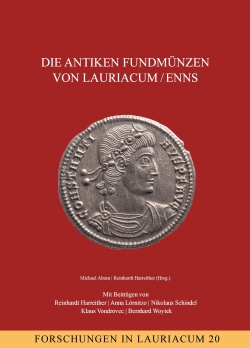
Im Laufe der letzten 120 Jahre wurden im Boden der antiken Stadt Lauriacum, an der Mündung der Enns in die Donau gelegen, knapp 32.000 antike Münzen gefunden, die überwiegend im Museum Lauriacum der Stadt Enns verwahrt werden. Schon aufgrund der Menge, und noch mehr aufgrund der überragenden Bedeutung Lauriacums für das römische Österreich, zählen die Fundmünzen dieses Ortes zu den wichtigsten antiken Kulturgütern unseres Landes. Für die Geschichte Lauriacums als Militärstandort, Knotenpunkt mehrerer überregionaler Verkehrsachsen sowie Verwaltungs- und Bischofssitz der Spätantike stellen sie eine der bedeutendsten Primärquellen dar und geben einen einzigartigen Einblick in den antiken Geldverkehr am Donaulimes. In seinem historisch-archäologischen Überblick zeichnet Reinhardt Harreither die Geschichte Lauriacums von den Anfängen der Siedlung um die Mitte des 1. Jahrhunderts, über die Stationierung der „legio II Italica“ um 190 n. Chr., bis in die Spätantike und ins frühe Mittelalter. Das Herzstück des Bandes bildet die numismatische Auswertung von Klaus Vondrovec, in der alle Aspekte des Lauriacenser Geldumlaufs systematisch erfasst, analysiert und in Beziehung zu anderen Fundplätzen gesetzt werden. Die Fundmünzen der Grabungen in der antiken Zivilstadt aus den Jahre 1951–1959 werden von Anna Lörnitzo einer gesonderten Auswertung unterzogen. Die keltischen Gepräge, die Münzen der römischen Republik sowie eine Auswahl an numismatischen Besonderheiten sind von Bernhard Woytek kommentiert. Den Abschluss bildet Nikolaus Schindels Kommentar zu den byzantinischen Geprägen. Der digitale Katalog ist unter https://doi.org/10.1553/Digitaler_Katalog abrufbar.
…
Over the course of the last 120 years, around 32,000 antique coins have been found in the soil of the ancient city of Lauriacum, at the influx of the Enns into the Danube, most of which are held by the Museum Lauriacum in the city of Enns. Due to the quantity alone, but due in even greater measure to the importance of Lauriacum for Roman Austria, the coins found here number among the most important ancient cultural finds in Austria. They are one of the most significant primary sources for the history of Lauriacum as a military site, the intersection of multiple regional transport axes and as a late antique administrative centre and bishopric, providing unique insight into monetary transactions in the Danubian limes in Antiquity. In his historic-archaeological overview, Reinhardt Harreither traces the history of Lauriacum from the founding of the settlement in the middle of the 1st century, through the stationing there of the “legio II Italica” in around AD 190, right through to Late Antiquity and the early Middle Ages. The centrepiece of the volume is the numismatic evaluation by Klaus Vondrovec, in which all aspects of the circulation of money within Lauriacum are systematically recorded and analysed and their importance relative to other find locations determined. The coins found in the excavations from 1951 to 1959 in the ancient civilian town are subjected to a separate analysis by Anna Lörnitzo, while Bernhard Woytek comments on the Celtic strikes, the coins from the Roman republic and a selection of exceptional numismatic specimens. The volume is brought to a close by Nikolaus Schindel's commentary on the Byzantine exemplars. The digital catalogue can be accessed at https://doi.org/10.1553/Digitaler_Katalog.
2023,
978-3-7001-8911-4
978-3-7001-9405-7
399 Seiten, zahlreiche Farb- und s/w-Abb.,
29,7x21cm, broschiert, Forschungen in Lauriacum 20, Denkschriften der phil.-hist. Klasse 549, Die Fundmünzen der Römischen Zeit in Österreich Abteilung IV | Oberösterreich | 2, Veröffentlichungen zur Numismatik 67